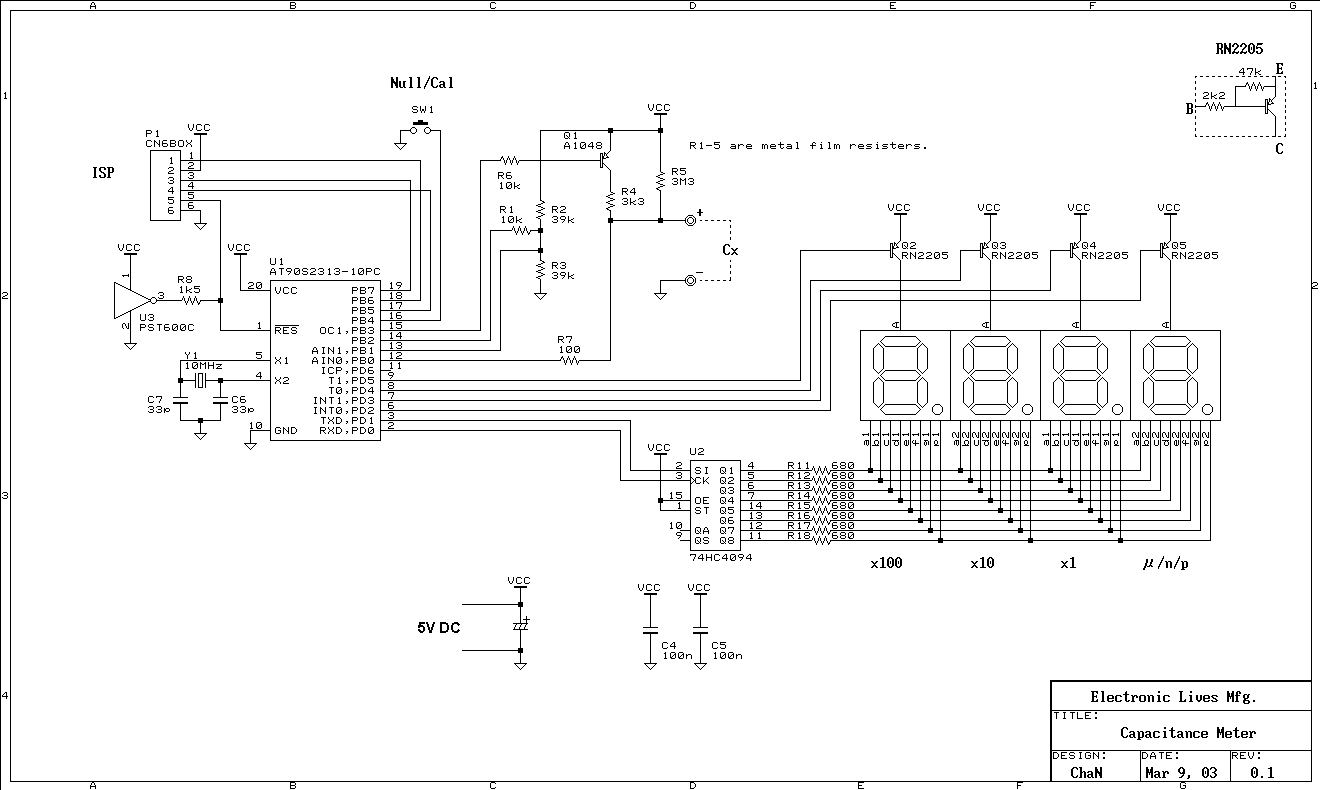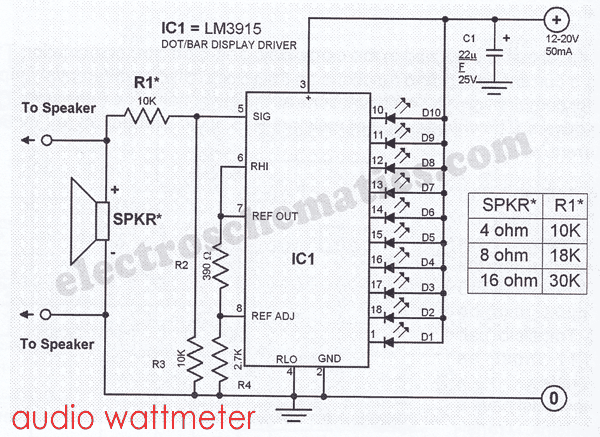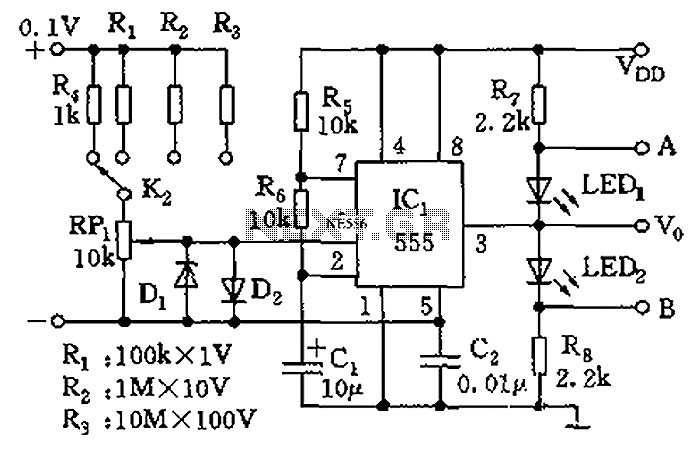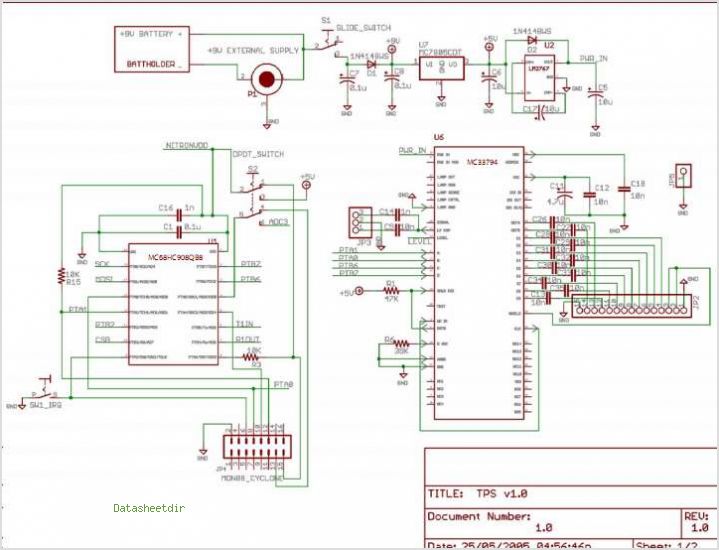
Field Strength Meter II
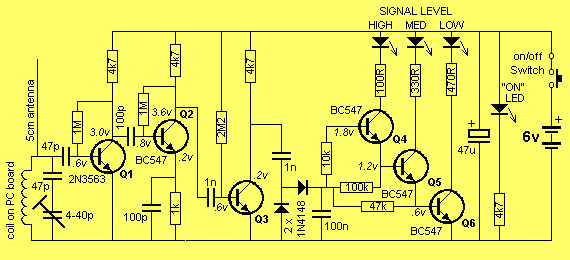
This project has 3 features. 1. It's a Field Strength Meter, 2. A Frequency Meter and, 3. An aid for testing detuned transmitters. Its uses will become clear in a moment but firstly let's go over the background of a Field Strength Meter. A Field Strength Meter is essential when designing and building transmitters. It provides signal strength values and allows us to compare and estimate the efficiency of a transmitter and its expected range. More: The circuit consists of a tuned front end, an RF amplifier, two further stages of amplification, a diode pump and a transistor staircase. The circuit picks up RF energy on its 5cm antenna and passes it to a tuned circuit where all the frequencies, EXCEPT
The described project encompasses a multifaceted electronic device that serves as a Field Strength Meter, a Frequency Meter, and a tool for testing detuned transmitters. Each feature of this device is crucial for applications in radio frequency (RF) engineering, particularly in the design and evaluation of transmitters.
The core functionality of the Field Strength Meter is to measure the strength of RF signals. This is vital for assessing the performance of transmitters, as it provides quantitative data regarding signal strength, which can be used to determine transmitter efficiency and expected operational range. The device operates by receiving RF energy through a 5 cm antenna, which is designed to capture a range of frequencies effectively.
The circuit architecture begins with a tuned front end that selectively filters the incoming RF signals. This section ensures that only the desired frequency range is processed, minimizing interference from unwanted signals. Following the front end, the RF signal is amplified using an RF amplifier, which boosts the signal strength for further processing.
The design includes two additional stages of amplification to ensure that the output signal is sufficiently strong for accurate measurement. These stages are critical in enhancing the signal-to-noise ratio, allowing for precise readings even in environments with significant background RF noise.
A diode pump is incorporated into the circuit to rectify the amplified RF signal, converting it into a form that can be easily measured. This component plays a key role in translating the RF energy into a usable voltage that corresponds to the field strength being measured.
Lastly, a transistor staircase is utilized to provide a visual representation of the measured signal strength. This component allows for easy interpretation of the readings, enabling users to observe variations in signal strength in real-time.
Overall, this project demonstrates a sophisticated approach to RF measurement, integrating multiple functionalities into a single device that is essential for engineers and technicians working with RF systems.This project has 3 features. 1. It`s a Field Strength Meter, 2. A Frequency Meter and, 3. An aid for testing detuned transmitters. Its uses will become clear in a moment but firstly let`s go over the background of a Field Strength Meter. A Field Strength Meter is essential when designing and building transmitters. It provides signal strength values and allows us to compare and estimate the efficiency of a transmitter and its expected range.
The circuit consists of a tuned front end, an RF amplifier, two further stages of amplification, a diode pump and a transistor staircase. The circuit picks up RF energy on its 5cm antenna and passes it to a tuned circuit where all the frequencies, EXCEPT
🔗 External reference
The described project encompasses a multifaceted electronic device that serves as a Field Strength Meter, a Frequency Meter, and a tool for testing detuned transmitters. Each feature of this device is crucial for applications in radio frequency (RF) engineering, particularly in the design and evaluation of transmitters.
The core functionality of the Field Strength Meter is to measure the strength of RF signals. This is vital for assessing the performance of transmitters, as it provides quantitative data regarding signal strength, which can be used to determine transmitter efficiency and expected operational range. The device operates by receiving RF energy through a 5 cm antenna, which is designed to capture a range of frequencies effectively.
The circuit architecture begins with a tuned front end that selectively filters the incoming RF signals. This section ensures that only the desired frequency range is processed, minimizing interference from unwanted signals. Following the front end, the RF signal is amplified using an RF amplifier, which boosts the signal strength for further processing.
The design includes two additional stages of amplification to ensure that the output signal is sufficiently strong for accurate measurement. These stages are critical in enhancing the signal-to-noise ratio, allowing for precise readings even in environments with significant background RF noise.
A diode pump is incorporated into the circuit to rectify the amplified RF signal, converting it into a form that can be easily measured. This component plays a key role in translating the RF energy into a usable voltage that corresponds to the field strength being measured.
Lastly, a transistor staircase is utilized to provide a visual representation of the measured signal strength. This component allows for easy interpretation of the readings, enabling users to observe variations in signal strength in real-time.
Overall, this project demonstrates a sophisticated approach to RF measurement, integrating multiple functionalities into a single device that is essential for engineers and technicians working with RF systems.This project has 3 features. 1. It`s a Field Strength Meter, 2. A Frequency Meter and, 3. An aid for testing detuned transmitters. Its uses will become clear in a moment but firstly let`s go over the background of a Field Strength Meter. A Field Strength Meter is essential when designing and building transmitters. It provides signal strength values and allows us to compare and estimate the efficiency of a transmitter and its expected range.
The circuit consists of a tuned front end, an RF amplifier, two further stages of amplification, a diode pump and a transistor staircase. The circuit picks up RF energy on its 5cm antenna and passes it to a tuned circuit where all the frequencies, EXCEPT
🔗 External reference
Warning: include(partials/cookie-banner.php): Failed to open stream: Permission denied in /var/www/html/nextgr/view-circuit.php on line 713
Warning: include(): Failed opening 'partials/cookie-banner.php' for inclusion (include_path='.:/usr/share/php') in /var/www/html/nextgr/view-circuit.php on line 713

